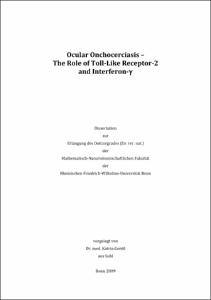Gentil, Katrin: Ocular Onchocerciasis : The Role of Toll-Like Receptor-2 and Interferon-γ. - Bonn, 2010. - Dissertation, Rheinische Friedrich-Wilhelms-Universität Bonn.
Online-Ausgabe in bonndoc: https://nbn-resolving.org/urn:nbn:de:hbz:5N-20528
Online-Ausgabe in bonndoc: https://nbn-resolving.org/urn:nbn:de:hbz:5N-20528
@phdthesis{handle:20.500.11811/4537,
urn: https://nbn-resolving.org/urn:nbn:de:hbz:5N-20528,
author = {{Katrin Gentil}},
title = {Ocular Onchocerciasis : The Role of Toll-Like Receptor-2 and Interferon-γ},
school = {Rheinische Friedrich-Wilhelms-Universität Bonn},
year = 2010,
month = mar,
note = {River Blindness is still highly prevalent in subsaharan Africa with millions of people suffering from the infection with Onchocerca volvulus. This filarial worm harbors the endosymbiont Wolbachia which was found to be essential for worm survival. The immune system of chronically infected individuals is constantly stimulated with worm proteins, lipids, carbohydrates and released Wolbachia from dying worms. In this study, I investigated the activation of the adaptive immune system by O. volvulus and Wolbachia in a mouse model of onchocercal keratitis.
Toll-like receptors (TLRs) are innate immune receptors that are activated by conserved bacterial and viral products. Lateley, it was also demonstrated that fungal and helminth products can activate selected TLRs. During filarial infection, stimulation occurs through both bacterial and parasitic products, I therefore focused on the role of TLR2 and TLR4 in the pathogenesis of adaptive immune responses and keratitis development.
Using a mouse model of onchocercal keratitis, I immunized C57BL/6, TLR2-/- and TLR4-/- mice with O. volvulus protein extract and examined granulocyte migration to the corneal stroma following local injection of this protein extract. I found that TLR2 was required for IFNγ production by splenocytes, CXC chemokine production in the cornea and neutrophil migration to the corneal stroma, but not for IL-5 production or eosinophil migration.
IFNγ was shown to increase surface expression of TLR2 on macrophages, priming them for further activation via TLR2 agonists like onchocercal protein extract. The pro-inflammatory cytokines produced by macrophages induced chemokine production by corneal fibroblasts. This is one pathway of IFNγ enhanced neutrophil migration to the corneal stroma.
Other parts of this study showed that pro-inflammatory Th1 responses were predominantly induced by the endosymbiont Wolbachia rather than the filarial worm itself, whereas Th2 responses were mainly induced by the worm.
One wolbachial protein that has been previously described and acts as immunomodulator is the Wolbachia surface protein. I characterized TLR2-dependent activation of primary macrophages and splenocytes and identified the region 121-240 of the protein as the main immunostimulatory domain.},
url = {https://hdl.handle.net/20.500.11811/4537}
}
urn: https://nbn-resolving.org/urn:nbn:de:hbz:5N-20528,
author = {{Katrin Gentil}},
title = {Ocular Onchocerciasis : The Role of Toll-Like Receptor-2 and Interferon-γ},
school = {Rheinische Friedrich-Wilhelms-Universität Bonn},
year = 2010,
month = mar,
note = {River Blindness is still highly prevalent in subsaharan Africa with millions of people suffering from the infection with Onchocerca volvulus. This filarial worm harbors the endosymbiont Wolbachia which was found to be essential for worm survival. The immune system of chronically infected individuals is constantly stimulated with worm proteins, lipids, carbohydrates and released Wolbachia from dying worms. In this study, I investigated the activation of the adaptive immune system by O. volvulus and Wolbachia in a mouse model of onchocercal keratitis.
Toll-like receptors (TLRs) are innate immune receptors that are activated by conserved bacterial and viral products. Lateley, it was also demonstrated that fungal and helminth products can activate selected TLRs. During filarial infection, stimulation occurs through both bacterial and parasitic products, I therefore focused on the role of TLR2 and TLR4 in the pathogenesis of adaptive immune responses and keratitis development.
Using a mouse model of onchocercal keratitis, I immunized C57BL/6, TLR2-/- and TLR4-/- mice with O. volvulus protein extract and examined granulocyte migration to the corneal stroma following local injection of this protein extract. I found that TLR2 was required for IFNγ production by splenocytes, CXC chemokine production in the cornea and neutrophil migration to the corneal stroma, but not for IL-5 production or eosinophil migration.
IFNγ was shown to increase surface expression of TLR2 on macrophages, priming them for further activation via TLR2 agonists like onchocercal protein extract. The pro-inflammatory cytokines produced by macrophages induced chemokine production by corneal fibroblasts. This is one pathway of IFNγ enhanced neutrophil migration to the corneal stroma.
Other parts of this study showed that pro-inflammatory Th1 responses were predominantly induced by the endosymbiont Wolbachia rather than the filarial worm itself, whereas Th2 responses were mainly induced by the worm.
One wolbachial protein that has been previously described and acts as immunomodulator is the Wolbachia surface protein. I characterized TLR2-dependent activation of primary macrophages and splenocytes and identified the region 121-240 of the protein as the main immunostimulatory domain.},
url = {https://hdl.handle.net/20.500.11811/4537}
}






